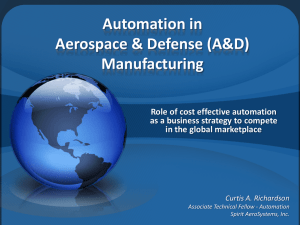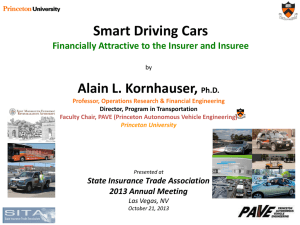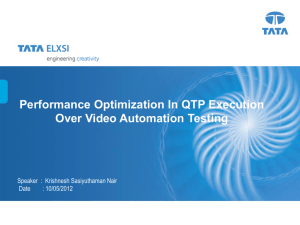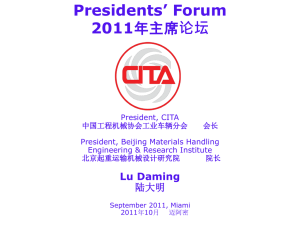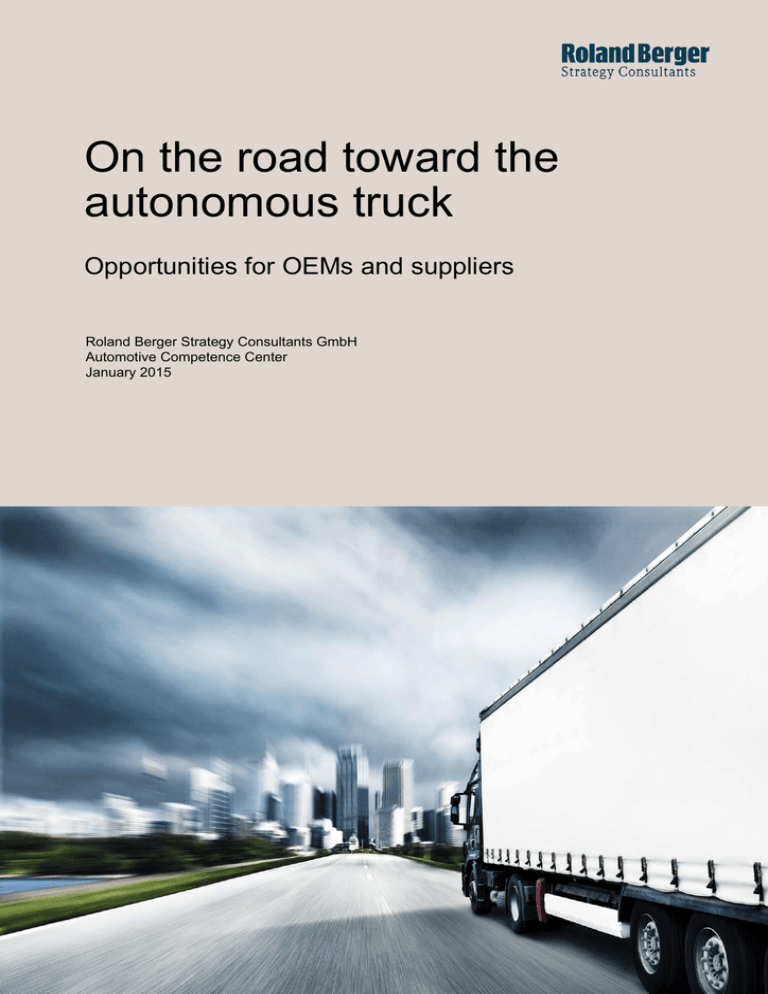
On the road toward the
autonomous truck
Opportunities for OEMs and suppliers
Roland Berger Strategy Consultants GmbH
Automotive Competence Center
January 2015
TRUCK ADVANCED DRIVER ASSISTANCE SYSTEMS
Introduction
Four megatrends will shape and transform the truck industry in the period through 2025 to make
it EFFICIENT, GREEN, CONNECTED and SAFE. The importance of SAFE is set to rise in the
coming years. Efforts to increase truck safety were strongly focused on reducing the impact of
truck-related accidents in the past. Advanced driver assistance systems (ADAS) now offer the
opportunity to achieve accident-free transportation.
With fewer traffic-related deaths and lower transportation costs, the expected benefits of ADASenabled (limited) self-driving trucks are compelling. Today, over 90% of all motor vehicle
accidents are caused by human error and were responsible for 26,000 deaths in 2013 in Europe
alone. The potential of automated driving in avoiding or mitigating accidents is huge. The
European Commission has therefore mandated that from 2015 onward all newly registered
trucks must be equipped with lane departure warning systems (LDWS) and from 2018 onward
with advanced emergency braking systems (AEBS).
Furthermore, advanced driver assistance systems (ADAS) will reduce the total costs of
ownership (TCO) of trucks. Today, the two largest factors in truck total cost of ownership are fuel
and driver costs. Functions that are available today, such as adaptive cruise control (ACC),
already enable fuel savings. In the future, vehicle-to-vehicle (V2V) and vehicle-to-infrastructure
(V2I) communication will greatly increase savings potential. The second-largest cost factor, the
driver, will still need to be in the cabin – at least for the next decade. However, in highly
automated trucks, drivers will now have time to engage in productive work like planning the next
delivery, or enjoy some leisure time.
"Limited self-driving trucks are not expected to reach series-production readiness before 2025.
The technology is almost there, but legal hurdles have to be overcome", states Sebastian
Gundermann, Partner in the Automotive Competence Center.
>
>
From a technical perspective, the main need for innovation is on the software side.
Systems must orchestrate highly complex driving behaviors and have a fail-operational
architecture that protects against technical failure and covers system malfunction. In
addition, the per-unit costs need to be further reduced.
A new legal (end insurance) framework is required before any autonomous trucks can
drive on public roads. Today, autonomous driving is prohibited by law. Key questions to
be addressed by a revised legal framework are liability (OEMs, suppliers, drivers) and
criteria to determine if the vehicle meets the required safety standards.
The trend toward autonomous driving requires action from both OEMs and suppliers. Roles and
responsibilities will be strongly influenced by the stage of automation. For OEMs, the main task
now is to prepare technologically for automated trucks by further developing ADAS
understanding on the vehicle and system level in-house. For suppliers, the future focus must
encompass both technology (sensor and software development) and effective business models
(for providing both complete systems and ADAS components only).
2
TRUCK ADVANCED DRIVER ASSISTANCE SYSTEMS
Table of contents
Introduction ..................................................................................................................... 2
A. MARKET DRIVERS FOR ADAS IN THE TRUCK INDUSTRY ................................... 4
B. SOFTWARE AND LEGAL CHALLENGES PRESENT THE GREATEST HURDLES 5
C. IMPLICATIONS AND KEY TAKEAWAYS .................................................................. 8
Authors .......................................................................................................................... 10
Publisher ....................................................................................................................... 11
Photo credits ................................................................................................................. 11
Disclaimer ..................................................................................................................... 11
3
TRUCK ADVANCED DRIVER ASSISTANCE SYSTEMS
A. MARKET DRIVERS FOR ADAS IN THE TRUCK INDUSTRY
In Pilbara, Western Australia, Rio Tinto's 53 autonomous trucks are moving tons of material
between the three mine sites at Yandicoogina, Nammuldi and Hope Downs 4. Together, the fleet
has now driven over 4 million kilometers on non-public roads and moved more than 200 million
tons of material. There is no driver behind the wheel. Instead, the trucks are supervised by
remote operators and respond to GPS directions.
On-road, however, we still have a long journey ahead of us before we will see autonomous
trucks. With fewer traffic-related deaths and lower transportation costs, the expected benefits of
autonomous trucks are compelling. Today, over 90% of all motor vehicle accidents are caused by
human error. In Europe alone, 26,000 people died in 2013 in road accidents, and for every death
there are another estimated four victims who suffer permanently disabling injuries. In emerging
markets, the situation is even worse: today's accident statistics are expected to double by 2030.
The potential of automated driving in avoiding or mitigating accidents is huge. Systems like
adaptive cruise control (ACC) have been estimated to be able to reduce truck-related rear-end
collisions, currently still the most common type of truck-related accident, by over 70%. The
European Commission has therefore mandated that from 2015 onward all newly registered
trucks must be equipped with lane departure warning systems (LDWS) and from 2018 onward
with advanced emergency braking systems (AEBS).
Furthermore, advanced driver assistance systems (ADAS) will reduce the total costs of
ownership (TCO) of trucks. Today, the two largest cost items in trucks are fuel and driver costs.
>
>
Functions that are available today, such as ACC, already enable fuel savings. In the
future, vehicle-to-vehicle (V2V) and vehicle-to-infrastructure (V2I) communication will
greatly increase savings potential. Vehicles will communicate with each other to
synchronize traffic flow to avoid start-stop driving patterns and traffic congestion.
Platooning, when a number of trucks drive together, has been shown to reduce the fuel
consumption of the lead truck by 8% and that of the following trucks by 14% when
traveling at 85 km/h.
The second-largest cost factor, the driver, will still need to be in the cabin – at least for the
next decade. However, in (limited) self-driving automated trucks, drivers will now have
time to engage in productive work like planning the next delivery – or enjoy some leisure
time.
4
TRUCK ADVANCED DRIVER ASSISTANCE SYSTEMS
B. SOFTWARE AND LEGAL CHALLENGES PRESENT THE GREATEST
HURDLES
The path toward autonomous trucks will lead through five different stages. Stages 1 through 3
are already a reality:
>
>
>
>
>
In the first stage, trucks are not automated and assistance systems provide truck drivers
with warning information in clearly defined scenarios such as lane departure (lane
departure warning system).
In the next stage, vehicle systems actively assist the driver in clearly defined driving
conditions such as in the event of lane departure (lane keeping assist system) for single
functions (e.g. steering).
In the combined function automation stage, vehicles take over driver tasks but not driver
responsibility. The driver must still be attentive and able to retake control any second.
Under limited self-driving automation, the driver can engage in other activities while the
truck, for example, chauffeurs the driver along the highway or through traffic jams.
The final stage is full self-driving automation where the driver is practically no longer
required.
5
TRUCK ADVANCED DRIVER ASSISTANCE SYSTEMS
Figure 1: Functional demands in the 5 stages of automation
No
automation
Functionspecific
automation
> Lane departure
warning
> Blind spot
detection
> Collision
warning
> Cruise control
> Autonomous
emergency
braking
> Lane keeping
assist
Combined
function
automation
> Adaptive cruise
control
> Lane change
assist
Limited
self-driving
automation
> Platooning
> Highway pilot
> Construction
zone assist
~2020
Full
self-driving
automation
> Fully
automated
driving –
highway, rural
roads, city
>2025
Source: Roland Berger
As can be witnessed on non-public land with Rio Tinto right now, the technology required for
autonomous driving is surprisingly mature. On public land, the Daimler 'Future Truck 2025' has
already traveled the first kilometers on a highway. Still, limited self-driving automated trucks are
not expected to be series-production ready before 2025.
6
TRUCK ADVANCED DRIVER ASSISTANCE SYSTEMS
Figure 2: Functional demands for automation
No automation/function-specific automation
2
Limited self-driving automation
2
Target values
for longitudinal,
lateral and
vertical vehicle
dynamics
Hardware
redundancy
1
Sensor/object data fusion incl.
calculation/prediction of vehicle
status
Additional information:
Vision, sound, memory
Combined function automation
3b Real-time dynamic spatial recognition
4b Planning, monitoring and control of global and local paths as
well as alternative possible safe trajectories
5 Fast decision making capabilities
Full self-driving automation
2
2
Decision
making &
control
1
Decision making &
emergency control
Emergency control
Hardware
redundancy
1
1
3b
3a Real-time "static" spatial recognition
4b
4a Planning (and monitoring/control) of a possible safe trajectory
5
Source: Roland Berger
To reach series-production readiness, advances in both sensor technology and the processing of
sensor inputs are required. Advances in sensor technology are expected to be incremental rather
than revolutionary. Next-generation camera sensor, for example, will offer higher image
resolution and radar sensors longer ranges. From a technical perspective, the main need for
innovation, however, is in the processing of sensor inputs, the software side. For early-stage
ADAS functions, the two required software capabilities are the processing of sensor data
(including combining input from more than one sensor) to estimate and predict the vehicle status
[1] and overriding the driver control [2] by providing (new) target values for different vehicle
systems (brakes, steering, dampers, etc.). For combined function automation, the system needs
to further understand the immediate environment (e.g. the road with its markers, the curbs,
obstacles, but also traffic laws and rules) and the exact location of the vehicle in that environment
(the traffic), what is known as "static" spatial recognition. Based on this understanding, a possible
safe path needs to be planned.
Limited self-driving automation has to deal with much greater complexity. It requires the
prediction and anticipation of the behavior of others – vehicles, pedestrians, animals – basically
everything that might create a potential danger in traffic, while simultaneous taking into account
the movement of the vehicle itself, thus "dynamic" spatial recognition. Based on this information,
the optimal route and trajectory has to be determined quickly. Full self-driving automation will
ensure, in addition, that the assistance systems are capable of returning to the minimum-risk
scenario under all conditions, so that there is no need for human backup anymore.
7
TRUCK ADVANCED DRIVER ASSISTANCE SYSTEMS
Overall sensor data fusion, spatial recognition, trajectory planning and control and decision
making will almost certainly be realized through centralized system architecture. To process
around 300 GB of data per hour, to integrate the truck with the cloud, and to implement stricter
security mechanisms, the in-vehicle network will switch to IP-based communication. The key
requirements of these architectures are safety and security. Systems must have a fail-operational
architecture that can still function in the event of minor errors and has a safe mode in case of
serious technical failure. Further, systems must be secure in order to prevent external access to
the system.
Besides the technical aspects, a new legal (and insurance) framework is required before we will
see (limited) self-driving automation on public roads. Today, autonomous driving is prohibited by
law as the driver needs to be in full control at any given time. Key questions to be addressed by a
revised legal framework are liability (OEMs, suppliers, drivers) and criteria that can be used to
determine if the vehicle meets required safety standards.
C. IMPLICATIONS AND KEY TAKEAWAYS
The trend toward autonomous driving requires action from both OEMs and suppliers. While roles
and responsibilities will be strongly influenced by the stage of automation, the definition of the
system architecture and system integration will remain the domain of OEMs across stages.
Overall, we anticipate a stronger decomposition of the value chain, with specialists dominating
specific 'functional clusters' that require specific competencies.
>
>
>
>
For function-specific automation, complete functions can be sourced by OEMs from
suppliers, including sensors and software (similar to pure warning functions in the noautomation stage)
Combined function automation requires a more complex interaction between sensors,
control software and actuators. These functions might be developed by the OEMs or by
specialized engineering service providers or suppliers
In a stage of limited self-driving automation, OEMs need to orchestrate component
supplier activities as single ADAS functions converge to enable comprehensive trajectory
planning and decision making functionality
In full self-driving automation, the end-game scenario, this "brain" module might be
rather standardized and configurable through parameters and models based on the
physics of the underlying vehicle. In such a scenario, economies of scale are crucial, and
it's possible that a large (software) player with a background in robotics may gain a
significant share of the overall revenue and profit pool – offering complete systems to
technology-follower OEMs at affordable prices
8
TRUCK ADVANCED DRIVER ASSISTANCE SYSTEMS
For OEMs, the main task now is to prepare technologically for limited/full self-driving automation:
>
>
Further develop ADAS understanding on the vehicle and system level in-house to have
relevant knowledge for designing limited/full self-driving trucks
Partition ADAS based on clearly defined interfaces and responsibilities to facilitate
interaction with the supplier base
Figure 3: Role sharing between OEMs and suppliers
Technology-leader OEMs
Level of
integration
No/functionspecific
automation
Combined
function
automation
Technology-follower OEMs
Limited selfdriving
automation
Full selfdriving
automation
No/functionspecific
automation
Combined
function
automation
Limited selfdriving
automation
Full selfdriving
automation
Vehicle
System
Component
Role of
OEMs
> Complete system understanding
> Integrate fail-operational vehicle safety concept
> Drive ADAS acceptance (regulation/customer acceptance)
Role of > Holistic ADAS understanding from components (sensors
suppliers
and algorithms) to complete systems
> Infrastructure co-development (V2V, V2I)
OEM
> Responsible for vehicle-level integration
> Development lead for affordable and secure ADAS
solutions
> Complete system competency including sensors and
software capabilities
Supplier
Source: Roland Berger
For suppliers, the future focus must encompass both technology and business models:
>
>
Develop advanced software capabilities and introduce next-generation sensor
technologies to approach series-production readiness for the stages of limited/full selfdriving automation
Build effective business models for providing OEMs with both complete systems and
ADAS components only
Roland Berger Strategy Consultants, founded in 1967, is one of the world's leading strategy
consultancies. With around 2,400 employees working in 50 offices in 36 countries worldwide, we
have successful operations in all major international markets. Within our Global Automotive
Practice we have a dedicated team of Commercial Vehicle experts serving our clients all around
the world.
9
TRUCK ADVANCED DRIVER ASSISTANCE SYSTEMS
Authors
Sebastian Gundermann
Partner Munich, Germany
+49 89 9230-8142
sebastian.gundermann@rolandberger.com
Norbert Dressler
Partner Stuttgart, Germany
+49 711 3275-7420
norbert.dressler@rolandberger.com
Marc Winterhoff
Partner Detroit, USA
+1 248 729-5520
marc.winterhoff@rolandberger.com
Wilfried Aulbur
Partner Mumbai, India
+91 22 3953-7502
wilfried.aulbur@rolandberger.com
Dr. Wolfgang Bernhart
Partner Stuttgart, Germany
+49 711 3275-7471
wolfgang.bernhart@rolandberger.com
10
TRUCK ADVANCED DRIVER ASSISTANCE SYSTEMS
Publisher
Roland Berger Strategy Consultants GmbH
Sederanger 1
80538 Munich
Germany
+49 89 9230-0
www.rolandberger.com
Disclaimer
This study has been prepared for general guidance only. The reader should not
act on any information provided in this study without receiving specific
professional advice.
Roland Berger Strategy Consultants GmbH shall not be liable for any damages
resulting from the use of information contained in the study.
Photo credits
All images licensed from Roland Berger Strategy Consultants GmbH if not
otherwise indicated.
iTunes Store
www.rbsc.eu/RBKiosk
Google Play
www.rbsc.eu/RBAndroid
© 2015 Roland Berger Strategy
Consultants GmbH. All rights reserved.
11


